#PixelJunk Eden
Text

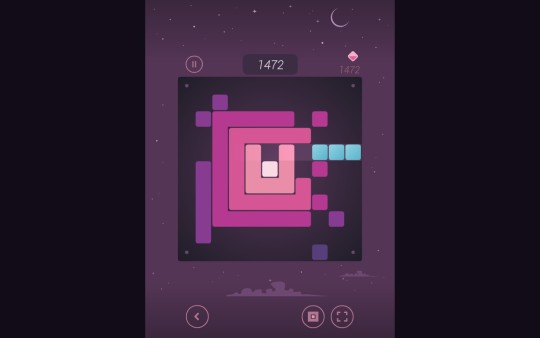


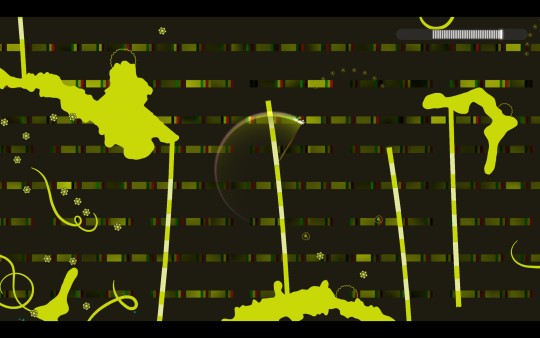



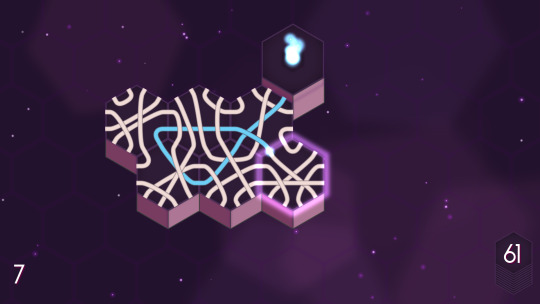
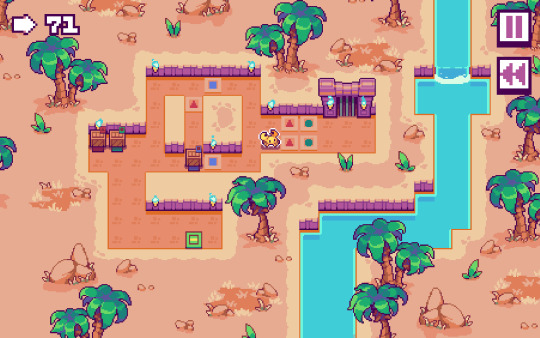
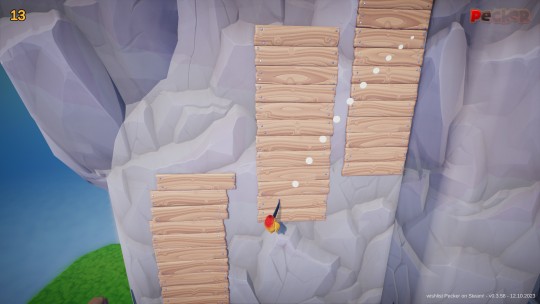
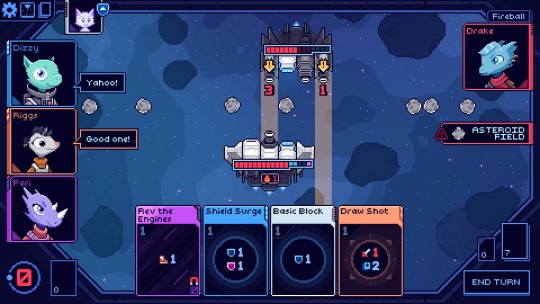
Steam Next Fest, fall 2023. I had time to play a good variety of game demos, and I picked out the ones that stood out the most to me this time around. Detailed thoughts and comments under the cut.
Beacon Patrol, Sky Settlers – The obligatory tile builders. Beacon Patrol plays like a variation on Carcassone; a bit more simplistic than its board game counterpart and I'd like to see more to it, but the idea of working together in multiplayer to set a high score is intriguing. Sky Settlers hews closer to Dorfromantik and ISLANDERS, and of the many games of that sort I've tried, it seems like one of the more fully realized ones. A lot of its ideas I've seen in other games and demos, but the ways they're used here feel pretty natural and fit together well.
Eklips, RETRIS, Oxytone – Arcade puzzle games, each of them putting a spin on an existing style of game: Oxytone places tiles to connect longer and longer winding paths, RETRIS plays like a somewhat warped version of Tetris, and Eklips drops blocks to fill out rows around a central square. There are some interesting ideas in each one, and good potential for them to be fleshed out a bit more.
Plungeroo, Oberty – More puzzle games. Plungeroo is a pinball-themed game about placing tiles and bumpers to make paths for pinballs to follow, with a charming variety of puzzles themed around different pinball tables. Oberty is a minimalist puzzle revolving around patterns and symmetry, and making different patterns out of the same base components. Both seem like the sort of game I might boot up, play a few levels, then a few more, then suddenly it's a day later and I've completed the entire game and am left wanting more.
Promenade, Pecker – A pair of games drawing inspiration from 3D platformers, in opposite directions. Promenade is a 2D platformer with a charming art style, and game mechanics somewhere on the spectrum between Klonoa or Mischief Makers (where the best way to get around is to grab enemies and vault over them) and Super Mario Odyssey (where each level is its own bite-sized collect-a-thon with challenges and objectives scattered throughout). Pecker takes a cue from Odyssey in a much more direct sense, in that it takes a specific power from a specific level and expands the core idea into an entire game based around it. Seems like both games could be refined into something fun.
PixelJunk Eden 2 – A floaty, psychadelic platformer. The gameplay is simple and satisfying, but takes a back seat to the audio-visual experience, which is overflowing with style. I'm not actually familiar with the PixelJunk series; I've seen the name around here and there, but never really looked into it myself. If Eden is anything to go by, I might have to rectify that.
Sandy's Great Escape – One last puzzle game, this one more sokoban-esque. A good pixel-art style, a good variety of mechanics that ramp up in complexity at a fair pace, and an incentive for optimal puzzle-solving (which might be a curse as much as a boon; I can tell that trying to 100% complete this game and get all the coins is the sort of thing that might drive me up a wall). The crab will have his day.
Cobalt Core – A roguelite deckbuilder. Of all the games I tried out this time around, this one was the standout. I was intrigued by the pixel art and music when it was first annouced (which also brought my attention to the devs' previous title, Sunshine Heavy Industries, which shares the same style and is a puzzle game that seems very much up my alley), and the gameplay did not disappoint. It clicked with me immediately, and puzzling my way through each different encounter was very satisfying. There's a lot of potential for different decks and encounters, so there should be a lot to dive into when the game releases. I'm looking forward to it.
#cobalt core#pixeljunk eden#beacon patrol game#plungeroo game#oberty game#eklips game#bryan writes about games
2 notes
·
View notes
Text
[Review] Eden Obscura (iOS) & Pixeljunk Eden 2 (NS)
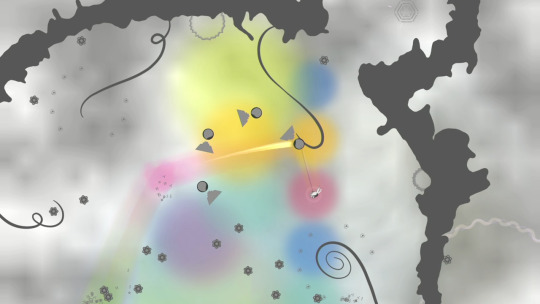
A messy mobile malaise.
I ended my review of the original Pixeljunk Eden hopeful that a sequel would smooth out some rough edges and iterate in interesting ways on an already experimental game. Instead what I got was a clumsy spinoff, an aesthetic rehash that pivoted into mobile game exploitation and shallow repetition.
Eden Obscura is the smart device iteration of this follow-up project, released ten years after the original. I’m not sure what Baiyon was doing in the meantime but many of the assets are recycled, from the minimalist interactables to the dreamy backgrounds and even the ambient techno soundtrack. The basics are the same: swinging on silk, bursting baddies, procuring pollen, sprouting seeds, and making your merry way to a magical MacGuffin. Only now your time limit is tiny, you have multiple mid-air directional jumps by swiping or you can hover in place, and you’re always being penalised for straying too far. The new “out of bounds” system locks in a play area from where you last jumped, and far too often you’ll accidentally fly or fall out.
As a mobile experience turning these large playing fields into bite-sized sessions makes sense, but they also turned something that leaned more towards chill puzzling and exploration into a frantic flick-a-thon. Sadly other mobile conventions crept in too: microtransactions, a lootbox system that awards one-time boosts. Worst of all is the “random content” dynamic, where you’re assigned a draw of levels and a playable character rather than allowing you a preference or any means of guiding your own experience.
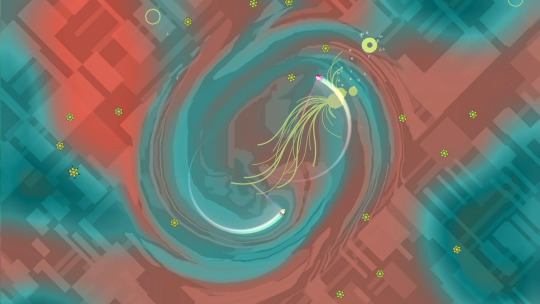
The little critters you play as—Grimps, as they’re called—each have their own gameplay modifier. This can be extending the timer when seeds are grown, boosting the speed of your jumps, or shortening your silk (why?). The original game had a few designs for P1/2/3, but they’ve added a bunch more here, many of them musos and DJs owing to Baiyon’s vocation (and I’ll note that from what I saw they’re overwhelmingly male). When you clear a set of levels and the lottery picks your next Grimp, you’re stuck with them until you beat the next set. It makes the game feel a right grind, repeating the same things and watching some bars go up, and I felt sad that it had come to this.
A side note that the “Obscura” in the name is a reference to cameras, and indeed your device’s camera will be constantly on while the app is running (not great for battery life). This is used to affect the backgrounds, as everything visible through the lens will be projected in-game in highly distorted fashion, as well as enabling some cheap gimmicks during gameplay like occasionally pointing at light surfaces for bonus time, or pointing it at specific colours between levels to eke out more boosts (with a cooldown timer, naturally). All in all it felt unnecessary.

So, I didn’t spend too long on Eden Obscura, keen to drop it and move on to the proper console sequel released two years later on the Switch. Little did I know that this now numbered sequel is little more than a port of the mobile game(!), now sans camera functionality. It’s a fully paid-up eShop game, but still has the one-time boosts and the loathed lottery system. At least the screen space is bigger and the timers more generous, but movement has for some reason been restricted: instead of half a dozen mid-air swipes and holds to build up your combo, you can now do one (1) extra directional jump after performing one aerial pause. And even though control is back to a controller, the controls themselves are completely different to the original game’s controls, and it just feels like you have less, well, control.
With only a drip feed of new content and a grating system of randomly enforced levels and characters, I got fed up pretty quickly with both implementations of this so-called sequel. I gave the mobile version a decent chance in some casual play sessions, but putting that experience on a console shows up its annoyances even more starkly and I didn’t play the Switch version for more than an hour. I’m done here. An ignoble end to my series on grappling games, and an object lesson that sometimes a sequel should be left at the back of the ideas drawer. If you have any interest at all in these games, please go check out the PC port of the original instead, which I’ve heard has a quality of life feature to save you from falls.
0 notes
Text
one of the guys i met this weekend makes melancholy ambient electronic music and it's so fantastic. makes me feel like i am a sandy beach being slowly washed away by the tide. bye bye brain
#also see:#smoking out your apartment window in the middle of the night while it's raining but you live in cyberpunk world#music that kind of sounds like pixeljunk eden ost if you removed all the percussive elements#music that puts you into a dissociative trance#music that melts your fucking brain#it's good
3 notes
·
View notes
Text
So like a decade ago, or I guess a bit more by this point, a bunch of indie games came out under the PixelJunk branding, and they got a decent amount of attention for what they were. They were generally all well made and tried a bunch of different things, so they were pretty well received. I'm pretty sure I only tried three of them and didn't really get along with two, but I really liked PixelJunk Eden way back whenever that was. Much to my surprise they made a sequel like 10+ years later.
The basic idea of both Eden and Eden 2 is the logical conclusion of what if platformer but no run, only jump? You can swing in a circle around whatever object you've landed on, launch yourself in whatever direction you want, land on something else, and repeat. Very simple, very few buttons, but they did it well enough that it's pretty satisfying the whole way through the game.
The main selling points are probably the art and music and overall vibe those create, and it's generally pretty chill if you're into the style of both of those things.
All those things are the same in 2, just like in the first one, but most of the things they changed make it less fun for me.
The biggest one is probably that there's only one goal/thing to collect on each level and no meaningful incentive to do anything else other than go directly to it, ignoring everything else. In the original you had to do several things to finish each level, and it did at least minorly reward you for doing optional stuff, but in 2 I felt like I was spending very little time in each level and only doing the bare minimum to progress.
The other major change is the "spice" system, where it gives you random powerups you can choose to use before starting a level. You get them by collecting enough of various things as you play through levels, and it could've been a fun way to change things around, but...it wasn't, at least for me. As soon as I realized they were consumable and not just things I'd permanently unlocked and could swap in and out I stopped bothering using them because they always felt like they either didn't do enough useful to be worth using or were so useful that I didn't want to waste them. Also it's so easy to finish everything without using them that that didn't really convince me to either.
When those are your main motivation to do anything optional in levels and there's very little non-optional they end up going by really quickly, mostly before I felt like I had to get used to the one I was on, and it kinda ruins the vibe a bit. A mode more like the original game unlocks after you've unlocked literally everything else in the game, but by that point I didn't really feel like doing any more beyond what I already had.
I did still have enough fun to get to that point though, and it's the kind of thing that works well in little bits and pieces here and there over a while, which is what I did with it in between doing other things. I feel like I'm making it sound worse than it really is, but mostly it just bugged me the whole time that it was pretty good but could've been better with a few relatively minor changes.
0 notes
Text
Demoscene and “Art” Games on PlayStation 3
Early in the seventh console generation, with the inclusion of storefronts allowing a user to download games on every home console, the ability to self-publish or be picked up by a publisher increased thanks to this new ease of access and lower costs of digital distribution as compared to boxed retail products. For Sony and the PlayStation 3, this would see the release of some games both Sony, games media, and players alike would sometimes deem non-games, especially those that came from a group of artists called demosceners which we’ll look at today.
Currently:
Linger in Shadows
.detuned
To be completed:
flOw
Echochrome
PixelJunk Eden
Flower
Noby Noby Boy
Journey
Datura
PixelJunk 4am
Papo & Yo
The Unfinished Swan
Proteus
Bound
Linger in Shadows

Released: Thursday, October 9, 2008
On: PlayStation Network for PlayStation 3
Developed by: Plastic
Published by: Sony Computer Entertainment America Inc.
Linger in Shadows was announced at the demoparty Breakpoint 2008 in Germany. Breakpoint was a successor to the demoparty mekka & symposium which ran from 1995 - 2002. Demoparties came out of the demoscene in which software crackers would create their own audiovisual effects and playbacks to be shared via demoparties, the internet, and inserted into cracked software. Organized parties would break the competition into categories of size and platform, letting the restrictions feed creativity. As explained by the organizers of the demoparty mekka & symposium:
What is MS?
The mekka & symposium is a demo-scene party that was organized annually at Easter. More than 1200 young Multimedia artists gathered here for four days in order to meet similarly-minded people, to exchange ideas and to participate in the competitions, in which individuals and groups show off their talents in a certain form of electronic art called Demos.
ms2002 has been the eighth and last event in a traditional party series that started back in 1995, when 300 mostly German visitors attended the BlackBox Symposium. To our 2002 event, about 1220 visitors came from all over Europe, and beyond - "sceners" have come to celebrate with us from countries as remote as Estonia and Israel!
The event was never a LAN or gaming party. People playing Qu*ke or Half-Life on our events would have been considered non-creative by our "serious" visitors, and as a matter of fact, the participation of gamers on our parties has always been exceptionally low, which made the MS one of the last big enjoyable events for real sceners.
Breakpoint would see its first iteration during Easter 2003, Friday, April 18 - Monday, April 21. The lead organizer was Scamp who detailed in an interview some of the difficulties in running the first party such as heating, internet access, attendance-to-expense, and getting permission to have the meeting during the Easter holiday in Germany. Attendance cost was reportedly €40.00 for men and no cost for women. It was during Breakpoint 2008 that the team called Plastic would reveal a video teasing the project Linger in Shadows for the PlayStation 3, with official confirmation coming later that year at E3.
Linger in Shadows was released on October 9, 2008 as an “interactive art” application for $2.99. Sony was quick to assert that this was not the typical PSN release. Rusty Buchert on the PlayStation Blog would state, “I’ll start with the easier side, and that is Linger in Shadows is NOT a game. It was never meant to be a game and it will never be a game.” In IGN’s “Impressions” piece on the game Chris Roper stated, “Linger in Shadows hit the PlayStation Network this week, but make no mistake - it is not a game. It even says so in about three different places just to make sure the point gets across. Instead, it's being dubbed as "interactive art", which is a pretty fitting description.” GameSpot’s Ricardo Torres would similarly remark, “While this isn't a game…”
“Games” are restricted to things such as Pac-Man, Madden NFL, or even LittleBigPlanet. Linger in Shadows is interactable (the player makes inputs and the game responds and reacts) though because it doesn’t fall into the traditional, high score, killing, or numbers-go-up categories so familiar to game players it becomes a non-game. Sony understood this and is why they would denote it as “not a game” themselves in its promotions. While seeking out the various titles listed at the beginning of this article the main things I was looking for were “art” games that lacked the traditional video-game framework such as a scoring system or games that had “artsy” visual styles but were really just dressing up a traditional platformer or point and click adventure game.
Due to its “non-game” status, reviews from release are fairly scarce. HonestGamers’ 1.5/5 community review by zippdementia says, “What bothers me is that this was such an obvious attempt to make an extra buck off the PS3 owner with overblown advertising. Next time, Sony, tell me what's really inside your package. Don't tell me you're going to give me cheese and then hand me Cheetos.” Eurogamer’s Dan Whitehead appeared to be the most adept at talking about the game in a “review” context, ending theirs with “Linger therefore exists in a strange new realm between the hardcore demoscene and the mainstream audience being asked to pay to play around with its peculiar concept. It's an interesting move if it opens up Sony's platform for more demos to reach a broader audience, but perhaps not if they have to pass through the gateway of establishment approval to get there. This experiment may at least tempt a few more people to Google "demoscene" and, payment aside, it's refreshing to see something so esoteric being championed in such a public way. You certainly won't see anything like this on Xbox Live or the Wii Store. That, at the very least, makes Linger in Shadows something rather special.”
Modern reviews have not been kind either, as Gamerhub’s ⅖ reviewer Steven Barry writes in 2022 that, “To be fair to developer Plastic, they do go out of their way to emphasise that this is not actually a game and is instead ‘interactive art’. So, it does feel a little strange to review this like any other game when in reality it’s a glorified tech demo. However, this was a purchasable product on release in 2008 over the Playstation Network so that is why it’s ultimately eligible for critique.”
Since most people were more preoccupied with grappling with its status as a “non-game,” there wasn’t much discussion about what it actually is and does. Linger in Shadows plays and unfurls itself as a dream. There is an unlogic to the procession of movement, space, and plot. The first signal of this is when watching the dog try and run through the air to escape the ethereal black cloud presence haunting the concrete setting. The dog's attempts to flee are vigorous, but without much effect, calling back to a shared experience nearly everyone who dreams has, of trying to run but finding you are unable to move at much more than a snail’s pace.
The game mostly finds itself following the presence of a black sentient cloud figure, as it moves about an impossible high rise grouping and its various unlogic features, such as a large flower atop a levitating rock, barrels similarly suspended in the air, and the biggest “tech-demo” flag of “how many moving objects of different shape and synchronicity can we have at the same time?” The black cloud can be interpreted as a malevolent entity even before it turns the dog to stone due to its coloring and the faint imagery moving about within it recalling the antennae of insects, both elements long associated with the impure. A cat impassively watches as the cloud turns the dog to stone, maybe something of a mirroring of the player impassively watching and even participating, without much of a feeling for what’s occurring on screen. Soon after, a giant creature bearing a mask with eyes and a body of trailing tentacles appears. In contrast to the black cloud, which effortlessly weaved in, out, and between various objects without much effect, this mask creature blunders its way toppling various objects as it seeks out the petrified dog which it also ends up breaking apart. Bearing familiar eyes and a more tangent shape than the ethereal black cloud, this mask creature is instantly interpreted as the “good guy.” Confronted by the black cloud, the mask ascends a pillar of stone atop of which is a semicircle of columns surrounding a statue of a woman. The black cloud begins petrifying the mask’s tentacles, furthering the black cloud’s villainy and the mask’s innocence as a victim. The “camera” is destroyed by a toppled column leading to the credits. As the demoscene is more about visual demonstrations than narrative, it's not surprising that the one displayed here is pretty simple and straightforward and more a way to show off different character models and what the player can manipulate.
The “game” portion of the game is that during this entire video playback you can at any point pause and manipulate the camera and objects on-screen. Since everything is a rendered object you can escape the usual limitations of regular video playback, and the UI even resembles the UI of media playback on the console or any DVD/Blu-Ray player of the time. The game itself will guide you through what types of manipulation you can do, with an additional hidden object portion tied to finding images that are shout-outs to other demogroups tucked away just out of frame. Playing Linger in Shadows is mostly a touch and go affair of moving the timecode forward and backward and moving around the controller and pressing buttons to see what sort of movement you can do in this specific frame or scene. Aside from whatever you can come up with yourself there isn’t any set of objectives beyond the tutorial teachings and then the image hunting collection.
It is this lack of purpose or list of things to do that I think most frustrates people into declaring Linger in Shadows “not a game!” Coming from arcades with high scores to home consoles with experience to accrue and levels to beat and people to shoot, we’ve been conditioned to think of games as filling a certain role and no other. Even Shadow of the Colossus in 2005 was heralded as the fulfillment of “Games as art” that would convince people like Roger Ebert of the medium’s value. That goal is self-defeating anyway, but also Shadow of the Colossus, while a phenomenal work, still falls into the traditional video game category quite easily, with the game bearing the objective to kill 18 colossi that are framed as unique boss encounters. While there is no progression in terms of level or equipment you do slowly increase our stamina and health over the course of the game. Nobody would mistake Shadow of the Colossus as an “interactive art piece” like they would Linger in Shadows, but both are video games.
Watching another of Plastic’s demos from 2008, called “Into the Pink,” many similarities come up, from more explicit bugs, more imposing crawling shadows, moving lots of objects floating through the air, and distorting text/images so that they jitter. Another project of theirs, “Catzilla,” is much more an entertainment object playing with destruction on a city-wide scale which just happened to come out the same year as Man of Steel and its similar experiments.
This art stands among the other “demoscene” game(s) on PlayStation 3 as a period when Sony was interested in courting the margins of games in order to sell its struggling console. At the time, the PlayStation 3 was in dead last place when it came to home console sales, and so Sony had to look at alternative ways to attract engagement. One of those ways was to present the PlayStation 3 as something more than just a video game console. Early advertisements for the PlayStation 3 are routinely mocked, though they really don’t stray too far from some of the advertisements for the PlayStation 2, such as those famously directed by David Lynch. These more “heady” adverts attempt to sell the console based not on gameplay footage but on an idea of what the console could do/be. It didn’t work.
Not until the Kevin Butler series of commercials did PlayStation 3 begin to majorly change its presentation to the larger gaming audience. PlayStation Plus, courting indies, and the humbled approach they took towards developers with the creation of the PlayStation 4, culminating in the disaster that was the Xbox One’s lead-up to launch, secured their continued success to this day. The cost of that success has been a lack of effort to engage the margins of gaming, something unofficially certified with the closure of its internal Japan Studio in early 2021 and further with the shuttering of PixelOpus and the announcement of ending support for MediaMolecule’s Dreams just this month. With its focus on huge titles, contemporary Sony would not throw money towards a group of students and tell them to “go wild” and release their demoware title on the PlayStation Network. The closest we have gotten in recent years was the release of Dreams, a game to create other games from MediaMolecule, itself a development team founded in part by a demoscene participant named Alex Evans known as Statix/TPOLM during the 1990s.
This is not to write off Microsoft and Nintendo’s attempts to court the indie space for success, as Xbox Live famously had its “Summer of Arcade'' titles, as well as being the console that really began today’s online network connectivity and distribution of smaller titles on the OG Xbox. Microsoft still had a restrictive storefront however, with file sizes and other limitations holding back small developers from seeking it out as the best place to try and publish their game. Nintendo also had some success with indie releases under the WiiWare brand (World of Goo and Bit.Trip Beat), but failed to do much to advertise or promote them.
One question that persists is in the intention behind the team of Plastic in creating Linger in Shadows. Dipping into demos and their productions, what strikes me is that the challenge comes from crafting advanced renders on platforms with limited and dated capabilities. As I’ll detail later, .theprodukkt was able to create a first person shooter with a file size of 96kb, and results for demoparties are broken down by platforms such as the C64, Amiga, and restricted file sizes such as 64kb. So why choose to utilize the PlayStation 3? Proudly boasted as the most powerful next-generation console in 2007, what appeal does that have to a group regularly challenging themselves to see what they can create using computers from the 1980s? Perhaps it was the challenge of working with the difficult to develop for CELL processor powered console. Perhaps they just thought it would be fun to swindle Sony out of some cash and just create whatever their whim deemed suitable for a wider audience instead of fellow demosceners. As I mentioned before, portions of Linger in Shadows definitely seem to be examples of the team simply trying to see how much they could get away with without breaking the game, though in 2023 it can be hard to look at it with the same eyes as someone in 2008, as graphics are continually chasing more and more fidelity with reality.
Shared between Linger in Shadows and the next demoscene game, .detuned, is Rusty Buchert, a producer at Sony Santa Monica who was the face of these demoscene games to the PlayStation audience at the time. Previously at Interplay Entertainment from 1990 - 2003, Buchert joined Sony Santa Monica Studio in 2003 and his major credits include flOw, Everyday Shooter, Linger in Shadows, Flower, .detuned, and despite his departure from the company in 2011 gained Special Thanks in Datura, Sorcery, The Unfinished Swan, and Sound Shapes. Speaking to Engadget in 2007, Buchert detailed his role as focusing on producing PSN titles for the PlayStation 3 and details what type of games and culture Sony was interested in cultivating.
We started searching for games like this [flOw] from the outset and we were searching through the Indie Scene right out the gate. In general the Scene thinks outside the traditional development box. All too often people get indoctrinated into one general way of thinking about games in genre, design, and execution. You are not going to get anything new thinking like that. We were betting on the fact that people wanted something new and not a rehash of a rehash of a rehash.
There are a lot of games to sort through. When we find a gem we start pursuing it. Some work out, some don't. I recently heard back from one developer that wanted to finish college and then he would like to try. The game made me think he was already programming professionally. There are some other experimental projects that will also fit in this vein too. These are very much art and an extremely different take on interactivity.
In a later post on the PlayStation Blog, Buchert also discusses how he, and another producer, George Weising (who is still at Sony today) scoured the Indie Games Festival booth at GDC 2007 where they found and signed a deal with the team behind Everyday Shooter. Their seeking out of indie games led to the next project from a group called Plastic.
Linger in Shadows developer Plastic was a Polish demogroup led by Michal Staniszewski (bonzaj). Alongside Staniszewski for all three Plastic projects were Grzegorz Juraszek (fei) and Damian Bajowski (mime). Those who developed Linger in Shadows and went on to Datura in 2012 are Krzysztof Deoniziak (rork) and Wojciech Golczewski (Blz). Shared staff between Datura and Bound, released for the PlayStation 4 in 2016, are Andrzej Uszakow (uho), Kinga Staniszewska, Marek Bielawski (mare), and Michał Szymczyk (misz). Plastic joined Epic Games in 2022, and was credited in Cyberpunk 2077 under “Outsource Partners,” though Staniszewski details on his Linkedin that the work was, “Responsible for visual development and prototyping of Cyberspace in Cyberpunk 2077.”
Grzegorz Juraszek (fei) is still active in the scene as he is the main organizer of the demoparty Riverwash, the largest of its kind in Poland. Damian Bajowski (mime) continues to work as an artist, most recently contributing to an episode of Netflix’s “Love, Death and Robots” called “Manson’s Rats.” Micahl Staniszewski (bonzaj) now works at Epic Games and has many YouTube videos talking about Plastic’s last game, Bound, which was released on PlayStation 4 in 2016. He has one lone video on the making of Linger in Shadows from December 2008. Krzysztof Deoniziak (rork) is also active in the scene, being credited on several demos in 2022. Wojciech Golczewski (Blz) continues to make music, though hasn’t been a participant in the demoscene since his time with Plastic early on. Andrzej Uszakow (uho) appears to still be at CD Projekt Red as a “Senior Engine Programmer.” I couldn't find much of anything to see what Kinga Staniszewska has been up to since Bound’s release. Marek Bielawski (mare) is currently a senior audio programmer at CD Projekt Red. Michał Szymczyk (misz) has the most surprising transition, while most of the developers stuck to Poland, Szymczyk is a Senior Software Engineer at the LA-based developer Infinity Ward starting in September 2017.
Plastic’s work on Linger in Shadow would be the first, but not only, demoscene game to find its way onto the PlayStation 3, as within a year of release another title from another demogroup would appear on the PlayStation Network.
.detuned
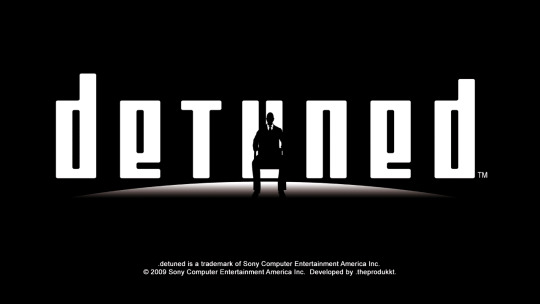
Released: Thursday, October 15, 2009
On: PlayStation Network for PlayStation 3
Developed by: .theprodukkt GmbH
Published by: Sony Computer Entertainment America Inc.
Developed by .theprodukkt, .detuned™ is a personalized, interactive music experience which gives you the opportunity to create dynamic artwork in real-time to accompany your XMB™ music collection. Manipulate the given scene by interacting with and modifying its unique graphics using the DUALSHOCK®3 Wireless Controller. Plus you can change and tweak your own music to accompany the scene. .detuned™'s brilliant design and capabilities call for the state-of-the-art processing power that can only be done on the PS3™ system.
Download .detuned™ today for an artistic music experience!
Features:
-Artistic Experiences: An abstract and surreal interactive experience to players of all levels and interests
-Personalized Music: Manipulate and tweak music tracks on the XMB™ to accompany your artistic creations
-Power of the PS3™ system: Stunning and crisp HD environment that brings your artistic visions to life in real-time
It started with a team of eleven people, a majority of which came from 49Games GmbH of Hamburg, Germany. 49Games GmbH’s main development was the annual winter and summer games for PC and consoles in Germany. Summer Athletics 2009 for Wii, released on July 24, 2009 was the largest collaborative effort, seeing nine of the eleven developers for .detuned credited on that game. An earlier collaborative effort is more closely related to the work of .detuned, a first person shooter game called .kkrieger. Released on April 10, 2004 for Windows PCs, .kkrieger was a product of the Breakpoint demoscene party in April 2004 in Bingen, Germany. It was the result of a challenge to create a first person shooter in the vein of Unreal Tournament and Quake but with the restriction of being 96KB in size. GameDeveloper has an interview with programmer Fabian Giesen (who was only 19 at the time!) and Nostalgia Nerd on YouTube has a great video documenting the development of .kkrieger that is worth a watch if you want to know more about how they accomplished this feat.
Sony Santa Monica Studios Producer Rusty Buchert announced .detuned on the PlayStation Blog on May 1, 2009. He said it would, “[offer] an abstract and surreal interactive experience like nothing else. It is not exactly a game or an art piece like Linger in Shadows. It allows you to create your own visual to accompany your favorite music tracks on the XMB, and using the SIXAXIS™ Wireless Controller, you will be able to manipulate the given scene by interacting with and modifying a man and his world. It even lets you tweak your music as you play with it.” Their announcement is already getting ahead of the “not a game!” crowd, though the comments on that PlayStation Blog piece are generally positive and welcoming.
.detuned would release on PSN for $2.99 on October 15, 2009. Games media reviews were limited, as most game “critics” were used to reviewing games such as Madden, Call of Duty, and Uncharted, but something like .detuned was challenging when approached from the limited scope of a consumer review with the stated goal being a buyer’s guide to “should you purchase this?” IGN gave it a 4/10, Bad, with Chris Roper saying, “Currently selling for $2.99 in the US PlayStation Store, that's about a dollar per minute of entertainment. If you have cash to blow and want to see one of the weirdest pieces of software on any system, go for it. Otherwise, just watch our videos and you'll get the point.” GamesRadar’s Shaun Curnow would rate .detuned 2.5/5 with its negatives being, “-Not really a game, -Won't amuse everyone, -Won't amuse for long.” Again we hit the same reactions and falsehoods of criticism, not being a [mainstream’s expectation of a] game, not reaching some imagined universal appeal, and not lasting long enough to be “worth” it in the mental formula of $/hour. A retrospective review in 2019 from Gaming Audio News’ Trevor Chan would say, “It didn’t take long to wonder if it was worth paying the small amount of money for this bite-sized experience. It’s a great snapshot of a bygone decade. Does that mean one would go recommending .detuned as a ‘must-play’? No, but it is worth experiencing, even if just for a few minutes.” Again we come back to reviews being centered on this one point: Monetary Price. No matter the time it costs you, don’t go questioning whether those 40 hours in the latest RPG were truly meaningful, be glad you got more bang for your buck compared to this!
As mentioned by GameSpy’s Sterlin McGarvey in their news writeup for .detuned’s announcement, Linger in Shadows, and .detuned, were positively regarded for their easy trophies, “It [Linger in Shadows] was also a handy way to clean up on some good trophies, another reason why many people picked it up.” This sentiment was echoed in PlayStation The Official Magazine Issue 22 for August 2009 whose Trophies for Cheaters by Carlos Ruiz includes entries for Linger in Shadows, Flower, and Noby Noby Boy. I admit, my purchase of Linger in Shadows and .detuned at the time was more for their easy trophies than interest in the demoscene or its history. It is only while looking back do I realize there is a richer field to examine than just a quick injection of trophy points.
What is .detuned if not a video game? The visual effects manually activated by the player suggests it is a visualizer meant to mesmerize you while enjoying your custom tracks imported onto the PlayStation 3 hard drive. Reliance on human, rather than machine, for these effects means the attention of the player is squarely on enacting movement to the rhythm of whatever track is currently being played instead of enjoying the track and visuals meshed together. Due to this, it reads as more of a toy, something to pick up and play around with, poking at its odds and ends, seeing what action you can provoke and manipulate, before setting it down and moving on. This briefness of experience and interest may be why publisher, reviewer, and player alike referred to it as, “not a game.” It failed, intentionally so, to entertain for multiple hours, tell a story, or offer a high score. Still, I find it limiting to restrict the moniker of “game” from .detuned and its ilk. The player can manipulate and control aspects programmed by the developer, engaging in a unique kind of conversation between player and program that can only happen in video games.
As a game, what does .detuned evoke? The first time through was spent poking and prodding at the game, seeing what the different button press combinations could accomplish and create in the suited man. The default track demo that you can watch to get an overall feel for what this game is capable of producing works well, though the cuts and camera movement seem way out of range of what the player is capable of producing when in control. The lack of an editable timeline means creating your own music video with this game as the base foundation would be a waste of time and effort. So, as before, it remains a toy, something you can plug a music track into in order to have some fun pulling and twisting it around in your hand, not quite as literal given the capability of the Sixaxis within the PlayStation 3 controller (though maybe for the best given the Sixaxis never achieved much in its lifetime). One of the tracks I chose to test out was probably the most apt for a repeatable batch of animations: Daft Punk’s “Around the World.” Some other experiments were on Blink 182’s “What’s My Age Again?” and M.O.O.N.’s “Hydrogen” from the Hotline Miami soundtrack. Unfortunately I did not realize I could turn off the sound effect to the “crank” noise when using the analog sticks to forward and rewind the animations. Due to this, my experience, and footage, are inseparable from the annoying click-clack of the crank.
In 2012 Q-Games released a game very similar to .detuned in intention, PixelJunk 4am, a game for the PlayStation Move motion controller that allowed players to, “Mix and create your own music with the PlayStation®Move. ‘Paint’ with sound in 3D space by pulling new tracks from the surrounding audio palette.” Though more social-minded than .detuned was, the audio effect manipulation and importing of your own custom tracks, aka your iTunes library, is very similar to the sandbox playground of .detuned, and is something I hope to try out once I obtain a PlayStation Move myself.
Some members of .theprodukkt continue to work in the demoscene today. Dierk Ohlerich (chaos) is an organizer for The Revision, a German demoparty that continues even to this year with an event in April 2023. Thomas Mahlke (fiver2) has continued working in the demoscene as well, most often with the group Farbrausch, one of the groups shouted out in Linger in Shadows. Tammo Hinrichs (kb) has also helped organize The Revision, and continues to make music for demos. Sebastian Grillmaier (wayfinder) has continued to create music for the scene and even provided the theme music for The Revision 2022. Christoph Mütze (giZMo) also appears to have remained active in the scene contributing to projects as late as 2021. Fabian Giesen (ryg) currently works at RAD Game Tools in Kirkland, Washington and maintains his blog to this day. Bleick Bleicken (mcfly) has most recently worked as an art director for Chorus developed by Deep Silver. I had trouble looking for any recent output from Oliver Waechter (joey) and Uwe Meier (moonlay). I believe Thomas Heinrich (aTom) is this same Thomas Heinrich on Twitter who links to Glare Productions as his current place of employment. Lastly Leonard Ritter (paniq) is currently a co-founder and developer at Duangle working on a crowdfunded game called Nowhere, an “alien life simulator.” The game has been in development since 2011 though sadly it appears the latest update was in March 2021.
Ever since my article on the short lived studio Endrant I’ve always wondered where these groups of people end up long after this project I’ve just played was probably last on their mind. Thankfully, in the comments of that Nostalgia Nerd video YouTube on .kkrieger there is a message from Tammo “kb” Hinrichs posted in October 2022 who gives an update on where the team is at now,
"Where are those guys now?"
We exist, living our lives, all outside actual game development nowadays (because we wanted to have lives), but still quietly working away on various things that you might or might not have seen. Some of us are still active in the demoscene, and we're all fine, thank you :)
3 notes
·
View notes
Text
Embodiment
-- PixelJunk 4am and the legacy of the Gutai Group --
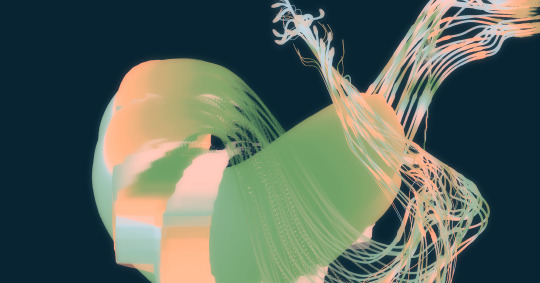
When the abilities of the individual were united with the chosen material in the melting-pot of psychic automatism, we were overwhelmed by the shape of space still unknown to us, never before seen or experienced. Automatism naturally made the image which did not occur to us. Instead of relying on our own image, we have struggled to find an original method of creating that space. - Jiro Yoshihara, in The Gutai Manifesto (1956)
European art witnessed the surfacing of its first unsystematic tendencies in the early decades of the 20th century, during which Dadaism and Surrealism rose and flourished. Artists like Bréton, Miró and Masson pioneered the technique of automatic drawing, in which art was conceived by the unrestricted will of the psyche, not unlike an earlier experiment in the realm of literature by Soupault. With a similar intensity and liberation from accepted norms, Jackson Pollock was among the first to propose and defend an attitude which later made his name synonymous with Formalism and post-modern Structuralism. According to his perception, the kernel of action painting, uniting plastic and performative arts as never before, surpassed that of a mere technique or methodology: to the North-American painter, the action or corporeal movement was the sine qua non condition preceding both the object and subject in art.
The influence of Pollock on abstract expressionism and other manifestations of post-war art, albeit felt throughout the world, was of particular significance to a Japanese up-and-coming artistic collective known as the Gutai group. Encouraged by the audacity of French Tachisme, this critical chapter of Japanese art history begun circa 1954; assuming a more definite posture upon the publication of Yoshihara’s The Gutai Manifesto two years after. Praising the work of Pollock and Matthieu, this essay advised a new and universal and distinctively Modern postulation, the culmination of the group’s long held desire to renew art by giving emphasis to the creative process itself, preserving the vitality of materials.
Half a century later, and as the first pioneers of this current have disbanded or, for the most part, passed away, the rise and fall of the Gutai movement was reduced to a sporadic footnote in a predominantly Eurocentric and excessively complacent History of Art. Nevertheless, a contemporary generation of Japanese artists and designers continues to carry the flaming torch of their irreverence, once lit at the height of modernity, paving the road for new and daring accomplishments in present-day media - most of which unimaginable prior to the age of digital emancipation. Kyoto-based artist and designer Baiyon has become a reference in his generation for carrying an identical creative philosophy to the fields of design, electronic music and digital art. His association with the retro-themed project Pixel Junk opened the door to this decade-old heritage, allowing it to exert its influence on a medium so far indifferent to legacy of Japanese embodiment. Eden, his earliest collaboration with Cuthbert’s studio, already incarnated many of the Gutai tenets, with its matchless dynamic visuals and remarkable aesthetic concern.
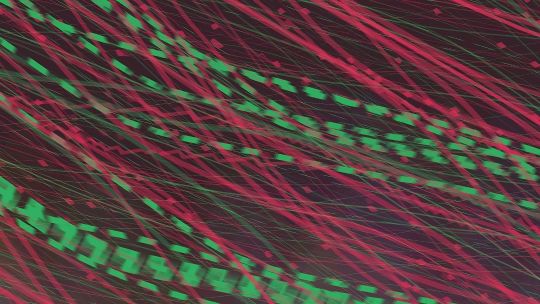
On the other hand, his most recent creation, entitled 4am, provides an even deeper insight into Baiyon’s subjective vision. Briefly, it consists of an organic audiovisual music generator relying on motion-sensing technology, an avant-garde ludic interface where graphics and sound blend seamlessly in real time. Operating in a minimalist and discreet environment, deliberately abstaining from the traditional presentation motifs or on-screen displays that tend to characterize video game presentation, 4am promotes the active creation or recreation of sound and forms; an interaction with a three dimensional space guided by the player’s own intuition and ingenuity. This unhindered creative principle is consonant with the drive that once fueled the insurgence of artists such as Shozo Shimamoto, Kazuo Shiraga and Sadamasa Motonaga.
Incidentally, the late Motonaga was a pivotal inspiration for Baiyon ever since his days as a student at the Seian University of Art and Design. His celebrated wet oil painting technique, for which he earned international recognition, relied upon disruptive factors such as gravity and chance in order to achieve an impromptu end result. Some of these aesthetic elements are conscientiously reproduced in Eden as well as 4am, as demonstrated by the dripping tints in the visual theme envelop you, envelop fish. The illustration style adopted by the young designer in other iterations, as is the case of his visual design label Wetside, reveals a similar concern for an attentive choice of colours, tones and vibrancy. Contrarily, shapes tend to reveal more volatile and fortuitous patterns, undoubtedly a product of his philosophy of applying for accident in design or, in his own words, an undeviating pursuit for serendipity.
The fundament of performative arts, be they of a spontaneous or premeditated nature, presupposes the presence of an audience. Like Fluxus, the Gutai advocated the superiority of conceptual art, or installment, as opposed to that of a stagnant art gallery exhibition, as many of their works existed often in the ephemerality of a single, fragile moment. The in situ birth of a new artwork was, in many regards, the most primordial of the group’s counter-cultural aspirations. Proportionately, this very same concept sustains 4am, wherein each singular performance can be projected to global stage through live streaming, unifying the audience and creator. Furthermore, by enabling viewers to record a reaction in real-time, all participants are invited to assume an active stance, analogous to that of a happening. In this regard, 4am incorporates Baiyon’s distinct nostalgic stimulus, the singular potential of new media and the very nightclub atmosphere in the search for a moment of affection, impulsivity and disinhibition.
To a great extent, the vanguardist attitude which the Gutai and other Japanese non-verbal artists espoused is vividly mirrored in this imperceptible space of action between the player/artist and the screen/canvas. The standard of pictorial gesticulation, in effect the concrete enactment of individual emotion, is thus coordinated by the liberating composition of arbitrary soundscapes; whereas neither picture nor the sound can be truly considered the essence of the trance-inducing abstraction. Baiyon's work converges with that of his radical precursors in their lifelong search for an evanescent ideal, capable of transcending time and technology.
Illustration source : official PixelJunk 4am website
This article is a repost of a 2012 article I wrote for my other blog, Post-Play.
#baiyon#gutai#art manifesto#japanese art#digital art#pixeljunk 4am#pixeljunk lifelike#playstation 3#playstation move
8 notes
·
View notes
Text
'PixelJunk Eden 2' Brings Its Hypnotic Platforming Action To PS4. PS5 And PC - Screens & Trailer
http://dlvr.it/Srk7Kf
0 notes
Text
[Review] Pixeljunk Eden (PS3)

Eye strain never looked this good.
When they announced the PS3 store would be phased out, I went looking for interesting things to buy. I’m familiar with Q-Games, the Kyoto-based company headed by Dylan Cuthbert, thanks to their work on the Star Fox series, and I was interested in the subgenre of vertically-oriented platformers. Now it heralds the approaching end of this series of reviews on grapple games.
Pixeljunk Eden is part of the largely Sony-exclusive “Pixeljunk” series of unrelated games. This was their take on a sidescroller, and a very unusual one it reveals itself to be. You play as a small plant creature hopping floatily around abstract spaces, spinning on a tether and racking up combos popping pollen seeds to grow plant platforms at designated nodes, to climb higher and ultimately find MacGuffins... and get a high score. I didn’t engage with the whole leaderboard system but it was obviously a key part of the design.
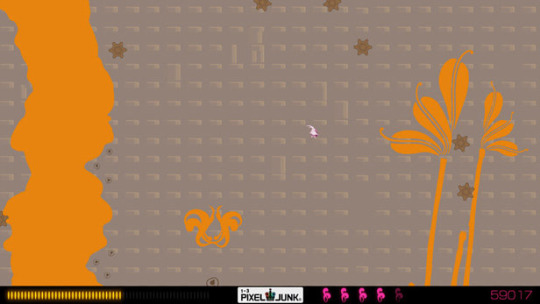
Each “garden” aka level (10 in the base game, 5 more with the Encore DLC pack) has five mystical somethings scattered around. The thing is, you’re forced to play through them five times apiece, each time getting one extra thingamajig during the run. Some levels are a bit more open but for many of them this means playing through the same sections the same way five times, which got tiresome. I didn’t like this design choice that prescribed the way you play, nor did I appreciate the arcadey time limit which causes even more repetition if you get too stuck or lost and run out.
At its best the game charmed me with its unique movement systems and the lovely feeling of opening up new paths by growing strange plants. A simple control scheme masks complexity: all face buttons do the same thing: jump, hold while jumping to spin a silk tether, hold in midair to spin (this attracts pollen, lets you pass through plants, and attacks some enemies). There’s also a tether retract button, and a gimmicky Sixaxis movement to stomp downwards, but the basics are solid. Bouncing back and forth on terrain, swinging around to soar through open air, knowing when to spin or not, these actions never lost their appeal.

By fully clearing the game you unlock a new mechanic, the ability to shoot a grappling thread out in midair. I really wish this had been an option from the beginning, as it was fun to use (and would have saved me a lot of time from falls!!) but with my mindset I had no reason to return to any level I had completed, no desire to improve my times or scores. It’s another symptom of the unfortunate prescriptivism baked into the game design, a philosophy that seemed at odds with the naturalistic, if alien, theme.
At this point I should mention the strong hand that Japanese artist Baiyon had in the game. He was behind both the driving trance soundtrack and striking visual style of the game. While I think both were valid artistic choices that give the game a strong identity, both ended up giving me a headache! The intense block-colour contrast style—very much like that seen in Q-Games’ DSiWare hit 3D Space Tank/X-Returns—coupled with the pulsing backgrounds would never fail to give me red, bloodshot eyes after a session. One of the few games I can say to have done me direct physical harm, along with what Crypt of the Necrodancer inflicted on my hands and wrists.
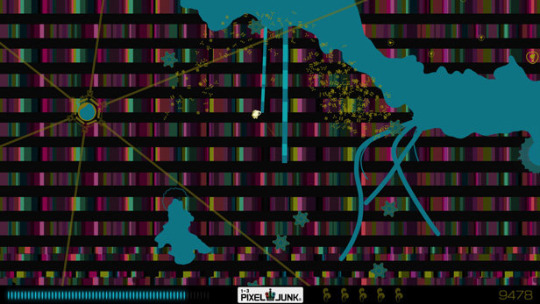
Ultimately my feelings are mixed. Many levels dragged on and were too punishing on mistakes, I didn’t jive with the arcadey structure, the enemies were strengthened too early which reduced the effectiveness of the tether, and the aesthetics came on a little too strong. But I have to admire Eden for its vision, and that unique gameplay loop. I just have to hope the sequels get a little more user-friendly.
0 notes
Text
Fotonica envirement

#Fotonica envirement android#
#Fotonica envirement plus#
#Fotonica envirement android#
Now they can do so while leaping around through the beautiful wireframes that Santa Ragione have given us.įotonica will be released as a Universal App for iPhone and iPad with an Android version coming at an unannounced date. Audio Visual Digital Arts Festival fotonica2021 19 > 27 November 2021 CITYLAB 971. Especially when you consider how often people walk around staring down at their phones. Create a national network with structure of equipment and. Ils conviennent à des applications telles que le. Ils sont donc principalement utilisés dans les environnements industriels, tels que l’industrie automobile, l’aérospatiale, l’électronique et des semi-conducteurs, ainsi que dans le secteur médical.
#Fotonica envirement plus#
Cest dans six stage quil faudra réussir à amasser le plus de points, dans des environnements toujours plus complexes mais à laspect graphique très minimaliste. Généralement, ce type de laser est concentré sur la puissance et le haut rendement. Opening new world with unique layouts and great ambient soundtracks is a motivation enough, but the truth is the gameplay itself is so addictive Fotonica immediately becomes a resident game for months to. Thus, Fotonica’s arrival for iOS comes as a breath of (digital) fresh air. Strengthen the area of photonics applied to agriculture, environment and agribusiness. Fotonica est un jeu de course de type runner, cest à dire que le joueur court sans cesse et naura comme seule action celle de sauter et/ou daccélérer. Fotonica offers a superb replay value for those who go solo and for those who like to compete and see their names on the global leaderboards. Les environnements requièrent de devoir sauter ou grimper pour pouvoir être. Dans les jeux de plateformes, le joueur contrôle un avatar qui doit sauter sur des plateformes suspendues dans les airs et éviter des obstacles. As it stands, the music in Fotonica already evokes the best sounds from Daft Punk’s work on the Tron: Legacy soundtrack, as well as the snarling immediacy of Trent Reznor. A Ground breaking Bio illuminationTM systems and analytics designed to increase crop’s yield quality and quantity while dramatically reducing costs. Un jeu de plateforme ou jeu de plate-forme (ou platformer) est un genre de jeu vidéo, sous-genre du jeu daction. Also new to the mobile version is the inclusion of two original tracks by electronica artist BAIYON, known to some as the composer for PixelJunk Eden. The iOS version of Fotonica will feature new levels, gameplay modes, and options. Pulling deep from their art and design backgrounds, Fotonica is a wireframe, minimal, trippy, that feels like leaping across the sidewalk in a techno nightmare. Energy & Environment, Finance & Insurance, City & Buildings, Digital Infrastructures. Developed by Italian design duo Pietro Riva and Nicolo Tedeschi, know together as Santa Ragione, Fotonica is not your average runner game. Fotonica is een belangrijke sector in Frankrijk. Elle stimule la production de collagène et d’élastine. Cette nouveauté permet de traiter en photorajeunissement et en raffermissement cutané de la peau par l’application d’énergie lasique. Hyper-minimalist runner Fotonica is coming to iOS this Thursday. Le traitement consiste en une stimulation de collagène tant de l’intérieur que de l’extérieur de la cavité orale.

0 notes
Photo









Baiyon - PixelJunk Eden 2 Original Soundtrack | Self-released | 2022 | Green, Gold & White Swirl + Red, Silver & White Swirl
#baiyon#pixeljunk eden 2#self-released#vinyl#colored vinyl#lp#music#records#record collection#vgm#video game music#electronic#soundtrack#q-games#pixeljunk
22 notes
·
View notes
Text
I got tired of seeing that Yoku's Island Express was on sale for $4 again for the seventh time this year, so I just bought it. Note that this tactic does not work for most games, and usually I'll just remove them from my wishlist if I keep getting constant notifications about them.
Anyway I was really impressed by it at first. It seemed really polished and well thought out, and everything is very charming. Looks great, felt good to play, and all that stuff, and who even makes a pinballvania?
I think I'm giving up on it now that I'm like 40% through the game according to my save file though. I managed to break it badly enough that it started running at maybe 1 fps and failing to load images, then a little while after I quit and reloaded it I managed to get it to stop playing sound unless the game was paused, and then a bit longer after that I discovered that the very clever layouts that prevent you from ever getting stuck anywhere are definitely not universal and got stuck somewhere I definitely could only have recovered from by reloading my save and losing progress.
I was having a good time, but three substantial bugs in relatively quick succession, two of which resulted in lost progress, is a bit much for me when the newest mechanic it introduced was already making me have less fun. I just do not enjoy the rope swinging thing. Not as a concept or anything, like I've played all the way through both PixelJunk Eden games, and they're built entirely around that mechanic. It just feels a lot better in those and like I can control where I'm going a lot better, at least partly because it's a little slower.
So yeah, quite good in some ways, but secretly underneath the very polished game I initially started playing was apparently a lack of polish that just kind of ruined my fun. Very surprised it turned out to be the buggiest game I've played all year, because I didn't expect that.
0 notes
Photo

PixelJunk Eden 2 launches on Nintendo Switch this summer.
PixelJunk Eden 2 from Q-Games: Jump, spin, swing and take out invading creatures to collect pollen and grow gardens back to full bloom. Along the way you’ll encounter a host of creatures and beautifully realized alien worlds to explore and liberate. Wallow in a feeling of synesthesia as the art and exquisite music from Baiyon envelops your mind and soul, and you, your Grimp and the delightful aesthetics of PixelJunk Eden become one. Enjoy this wonderland alone or with a friend via local multiplayer.
13 notes
·
View notes
Text
Nintendo Download for 12/10/2020
Nintendo Download for 12/10/2020
We’re back for the second Nintendo Download of December 2020. This one is a shorter one, with three featured titles and a somewhat shorter selection of new eShop games. We also have one major sale to look at, which is in celebration of The Game Awards.
Featured Games
First up we have DOOM Eternal ($59.99). The game is a direct sequel to DOOM 2016. Take on the armies of hell that are invading…

View On WordPress
0 notes
Text
PixelJunk Eden Obscura Announced For iOS and Android!
PixelJunk Eden Obscura Announced For iOS and Android!
PixelJunk Eden is one of my most favorite games I’ve ever played. It’s soothing, visually striking and still holds up just fine today. The game originally came out as a downloadable title on PS3 in 2008, but now a new follow up has been announced called Eden Obscura. Q-Games announced that it’ll be out for iOS and Android smartphones. Baiyon, the person who was in charge of all of the audiovisual…
View On WordPress
0 notes

